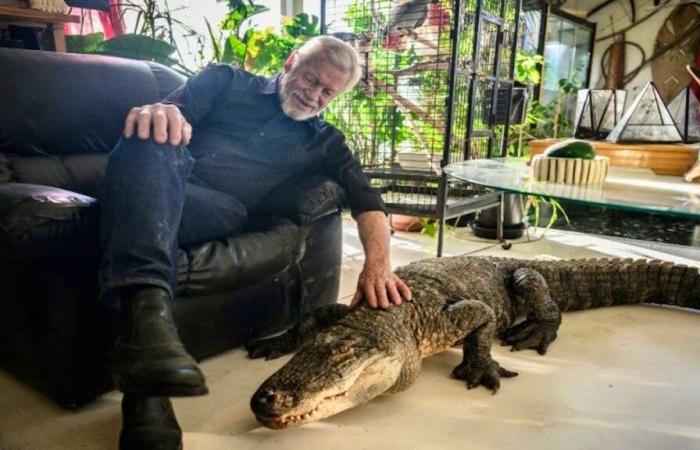Philippe Gillet becomes a YouTuber to save his wild animals.
AFP
Gator, an alligator measuring more than two meters, appears to be sleeping in a corner of Philippe Gillet’s living room near Nantes, in western France, but he greets an unknown visitor who enters the room with a disturbing growl. “You calm down!”, his 72-year-old owner successfully orders him.
A scene filmed and published several times on YouTube and which has accumulated several million views spread across different channels including that of its association Inf’Faune (information on wildlife).
Philippe Gillet shares his passion and his way of life, among the around 400 wild animals sheltered in his pavilion in Couëron, about twenty kilometers west of Nantes: Gabon vipers with deadly venom, spitting cobra, python, turtles alligators whose bite can sever a finger, tarantulas and other scorpions…
Still alongside Gator, Alli, another alligator of the same size, continues his nap.
“On stormy evenings, he comes to sleep in my bed,” laughs Mr. Gillet. And adding with a broad smile: “people think I’m crazy.”
From the age of 20, in Africa, he went into rivers to catch alligators to keep them away from villages under the incredulous eyes of the Pygmies, he says.
Returning to live in France at the age of 30, this ex-hunting guide used his experiences to become a herpetologist, a specialist in reptiles and amphibians.
He moved to Couëron, with the mother of his children, in a house similar externally to his neighbors… In appearance only: in the garden, neither dog nor cat. Nilo, a Nile crocodile, “one of the most dangerous species”, basks in the sun, chickens wander a few meters from him.
Most of these animals, Philippe Gillet bought or recovered from individuals who wished to part with them, or “in very rare cases from customs”.
“It’s better to welcome them, because it’s problematic to release them. With global warming, released cobras can breed and spread. This is what we are going to leave to our children, new dangerous species,” he warns. “In rarer cases, we can also recover species that have slipped into containers and due to the risk of disease we can no longer send them home.”
Hundreds of thousands of subscribers
To continue financing your project, becoming a content creator will be essential.
After the Covid-19 epidemic, his association no longer had the opportunity to organize animal exhibitions free for the public and financed by shopping malls.
“It represented 100,000 euros in turnover,” regrets the herpetologist. An amount that allowed him to maintain his numerous animals with the twenty volunteers from his association.
“Making videos on social networks was the only way to continue providing information for free,” explains Philippe Gillet.
For a year and a half, he has continued filming, presenting all his animals – “Crocodile tour”, “Mygale tour” – in videos mixing humor and pedagogy, with the aim of “demystifying legends and preconceptions about wild animals “.
And it works: “We had the trophy of 100,000 subscribers in just four months!”, says the reptile enthusiast.
Today, the association has nearly 200,000 subscribers on YouTube, and nearly 700,000 on TikTok. It generates the income necessary to get its head above water.
Securing the future
Because Philippe Gillet is getting older and he knows it: “Alligators live 100 years on average and Alli and Gator are in their thirties, it’s the volunteers who will take over.”
He shares his knowledge with them and passes on his passion, drawing on the training he gave to customs officers a few years earlier.
The herpetologist has set a new objective: “to create his own refuge specializing in reptiles”, in a more suitable place than a suburban house crammed with vivariums and cages. Thanks to his internet community, he has already raised more than 15,000 euros to achieve his goal.
Although he has authorizations from the French authorities to own his reptiles and insects, he has launched the process for his structure to be recognized as a refuge. “There are shelters for dogs and cats. Why aren’t there any for these unloved?”
(afp)






